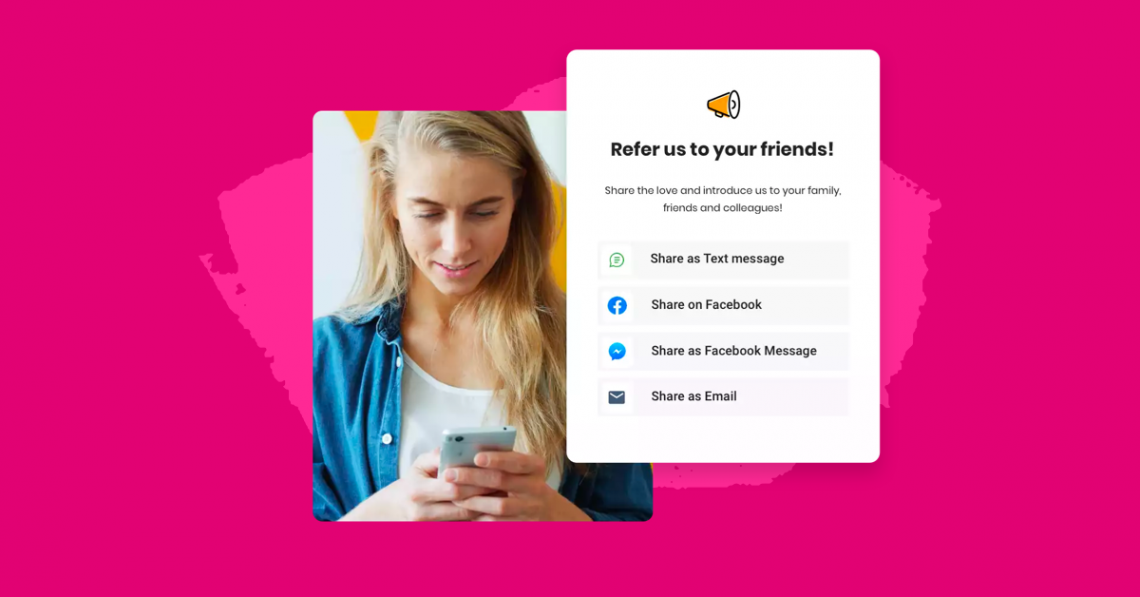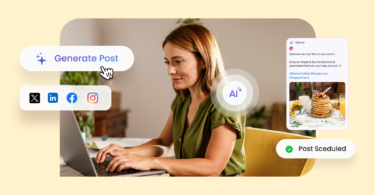Referral marketing is a powerful tool for businesses to expand reach and build trust with new customers. As per a Birdeye study, 54% of marketers say they’re responsible for bringing in referrals from their customers’ friends and family.
When someone recommends your business, it immediately creates a sense of trust, positioning it as a top-of-mind choice. By leveraging personal recommendations, businesses can gain new customers and strengthen their relationships with existing ones.
Did you know that the Birdeye Referrals platform allows businesses to automate requests and track referrals? This makes the process efficient and measurable.
In this article, we’ll guide you through how referrals are your modern word-of-mouth marketing method and how to effectively implement Birdeye Referral marketing software.
Table of contents
- Chapter 1: Referral marketing explained
- Chapter 2: How your business can grow with referral marketing
- 8 reasons why you need a referral program
- How to build a strong customer referral program?
- Referral marketing for B2B vs. B2C
- How do these differences impact referral marketing strategies?
- Examples of referral marketing programs
- Birdeye Referral – Your ultimate referral marketing solution
- Best practices for your referral program
- Frequently asked questions about referral marketing
- Build a strong referral marketing program with Birdeye
Chapter 1: Referral marketing explained
Use these fundamentals to start your referral program for your business.

What is referral marketing? Referral marketing is a strategy used by businesses to promote their products or services through referrals from existing customers. This approach leverages satisfied customers' trust and personal connections to gain new ones. All these help: - Builds brand credibility - Expands market reach - Encourages customer engagement - Creates social proof - Simplifies customer acquisition
How does referral marketing work?
Referral marketing, or word-of-mouth marketing, works just like it sounds. The goal is to get your customers to tell their friends and family about your business, but you can’t rely on it to happen organically.
Referral marketing requires you to encourage your customers to talk about you directly. So, rather than waiting for your happy customer to talk about you by chance, you can politely ask them to spread the word after a positive experience with your business.
Here’s a simplified breakdown of how it works:
- Looking at existing customers as advocates: The process begins with you (as a business) motivating its current customers to refer new customers.
- Incentives for referrals: Offer incentives, such as discounts, rewards, or free products, to both the referrer and the referred new customer.
- Sharing through various channels: Customers share their unique referral codes or links via social media, email, or word-of-mouth.
- New customer engagement: When someone signs up or makes a purchase using a referral code or link, they are counted as a referred customer.
- Rewards redemption: Once the referral is confirmed, both the existing customer (referrer) and the new customer receive the promised incentives.
Note: Track these referrals and analyze data to measure the success of the referral program and make necessary adjustments.
This approach capitalizes on the trust of existing customers, making it a powerful and cost-effective marketing strategy.
Birdeye has revolutionized how we do business. We’ve seen a real increase in customer satisfaction and a new surge in customers coming to us directly from seeing our internet presence (vs. a friend/family referral). The Birdeye Messenger integration into our website has helped us capture and convert more leads than ever!
Echo Wireless, Brandy Mills
Why referral marketing is so important?
Human beings are social creatures by nature, so it’s no surprise that we tell our friends and family about our experiences – good and bad. With 92% of customers trusting recommendations from the people they know, when considering the importance of referrals, it’s clear that referral marketing can be an effective tool to bolster your brand when used correctly.
The key is deliberately influencing happy customers to talk about their experience with you. Whenever a customer has a great experience with your business, you can easily ask them in person, via email, or by text to tell their friends about it. This can be a simple message like,
“We’re so glad you had a great experience with us. Please, spread the word with your friends.”
A quick, simple message like this can mean the difference between your customer going on with their life or marketing your business for you when they talk to their friends.
How word-of-mouth marketing works
Word of mouth is a powerful concept. We tend to take advice from those who have earned our trust, like our friends, family, or coworkers. Think about it, have you ever asked a friend or family member for restaurant suggestions, what dentist they use, or where to take your car for repairs? If so, then you are familiar with the concept of word-of-mouth marketing.
Word of mouth marketing is effective because it helps businesses:
- Gain customer trust
- Establish social proof
- Remain at the top of customers’ minds
Word of mouth presents a unique opportunity for businesses because it can put you on a fast track to earning customer trust. When your business is recommended to someone by someone whose opinion they trust, it makes it more likely that they would check out your business. This is how word of mouth builds customer trust right out of the gate.
Social proof is closely related to word of mouth. Social proof is the idea that people generally are influenced by other people's experiences.
For example, if prospective customers read great online reviews about your business, they will be more inclined to do business with you.
Naturally, they will think if other people had a great experience with your business, they will too. Customer recommendations are another form of social proof.
Finally, word of mouth helps your business stay at the top of people’s minds.
Let’s say you have friends who go to the same dentist, and they have all recommended this practice online. Chances are, if you need to switch to a new dentist, that practice will be the first one you will think of. The more people talk about your business, the more customers you will attract.
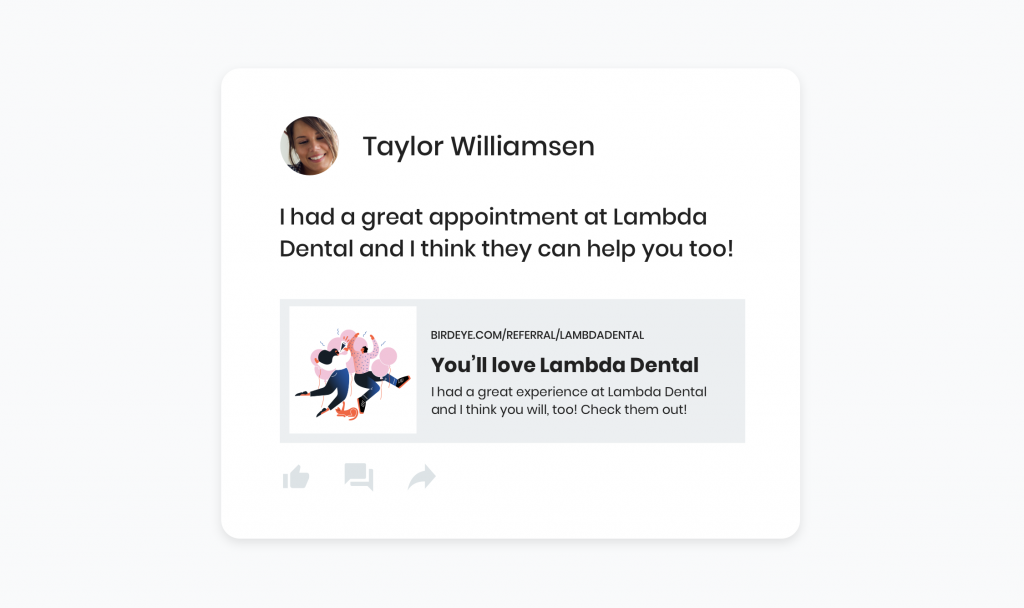
What are referral rewards?
Referral rewards are incentives businesses provide to encourage their existing customers to recommend their products or services to others. These rewards are a strategic approach to leverage word-of-mouth to gain new customers. The concept is straightforward: when a current customer refers a friend or family member, and that referral leads to a new customer or sale, the referrer receives a reward as a token of appreciation.
Types of referral rewards
- Cash or cashback: Monetary rewards, either direct cash or cashback, are simple yet effective. They provide a direct financial benefit to the referrer.
- Discounts on products or services: Offering discounts on future purchases can encourage the referrer and the referred individual to engage further with the company’s products or services.
- Store credit: Similar to discounts, store credits are a monetary equivalent that can be used for future purchases within the same business.
- Free products or services: Providing free products or services as a reward can enhance customer loyalty and can be a great way to introduce customers to other offerings.
- Branded swag: Offer branded items like t-shirts, mugs, or other merchandise as a fun and tangible way to thank customers for their referrals.
- Gift cards: Gift cards to popular retailers or for the company’s products/services offer flexibility and are generally well-received by recipients.
- Free subscription periods: For businesses with a subscription model, offering a free subscription period can be an enticing reward.
- Charitable donations: Some companies offer to donate to a charity of the referrer’s choice, appealing to the customer’s philanthropic side.
- Referral gifts: Personalized gifts or gift boxes can be sent as a more unique and memorable token of appreciation.
Choosing the right referral reward
Selecting the appropriate type of reward depends on various factors, including the nature of the business, the target customer base, and what would be most appealing and motivating to the referrer.

What is a customer referral program?
Customer referral programs are referral marketing in action. Customers are encouraged to refer the business to family and friends through email, SMS text, Facebook, or other online platforms. Here are the different types of referral marketing programs:
- Direct referral program: When you request a referral and offer a reward in return.
- Implied referral program: In an implied referral program, your business finds ways to let your target market know that you are working for similar clients.
For example, let’s say you are an electrician. You could create a pamphlet that showcases your work and leave it at real estate offices and property management offices to serve as a brochure for your business. Implied referral programs are less direct and more difficult to track, yet they can still be effective.
- Tangible referral program: This is when your business offers a product or service for free. For example, many meal subscription services run tangible referral programs by giving referred customers their first meal free of charge.
- Community referral program: This is when your business partners with a non-profit in hopes that the non-profit organization will, in turn, support your business.
The referral program that is the most trackable and scalable is the direct referral program. In this section, when we discuss referral programs, we are referring to direct referral programs unless otherwise stated.
There are two types of reward systems, or incentives, for direct referral programs:
- One-sided reward: Just the customer referring your business to someone they know is rewarded.
- Two-sided reward: Both the customer and the person referred to receive a reward for participating in the referral program.
As you likely could have guessed, two-sided rewards are more effective in referral marketing. With a two-sided reward, your happy customers will be more motivated to give referrals, and the referred party will be more likely to follow through with a purchase if they receive a reward or discount.
Enhance Customer Engagement Through Referral Marketing
Want to see the impact of Birdeye on your business? Watch the Free Demo Now.
Birdeye’s enhanced AI capability and impact on businesses
Birdeye has integrated advanced AI technology, BirdAI, to elevate referral marketing strategies. This enhancement significantly empowers businesses to get more leads with automated referral campaigns:
1. Automated referral insights: BirdAI’s algorithms analyze customer feedback and interactions to identify potential referral opportunities. This automated insight helps businesses target satisfied customers more likely to refer others.
2. Personalized communication: With BirdAI, the referral platform allows personalized messaging and customer interactions. By analyzing customer data, Birdeye Referrals ensures that referral requests are timely and relevant.
3. Efficient referral tracking: Birdeye’s referral platform can efficiently track referral sources and measure the effectiveness of campaigns in real time. BirdAI’s data-driven approach enables businesses to optimize their strategies for better results.
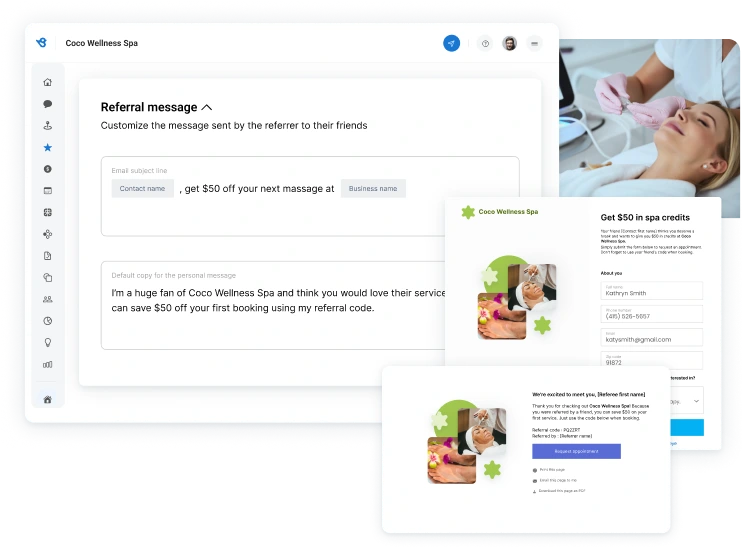
4. Enhanced customer experience: AI-driven analytics provide deeper customer preferences and behavior insights. This knowledge can help you tailor your products and services to what’s currently in demand.
5. Scalability and adaptability: BirdAI’s capabilities allow businesses to scale their referral programs efficiently. As it can adapt to changing market trends and customer behaviors, referral marketing strategies remain effective over time.
6. Incentive management: Birdeye simplifies the management of referral incentives. When you integrate it, you can easily set up and manage the rewards for both the referrer and the referred customers.
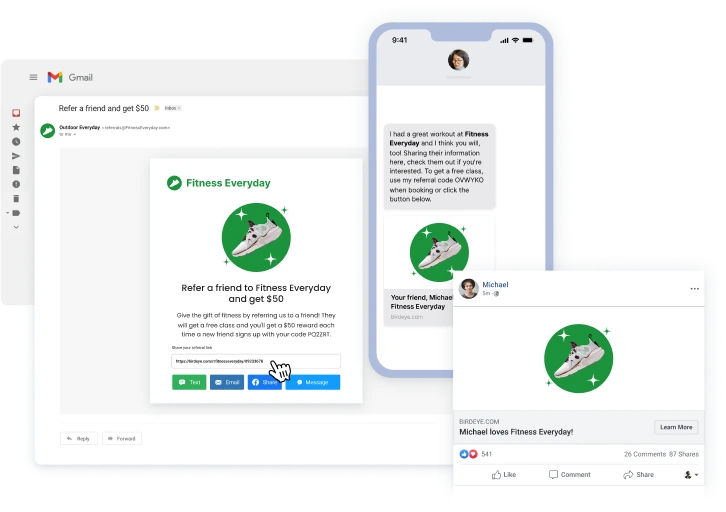
By leveraging Birdeye’s enhanced AI capabilities, businesses can supercharge their referral marketing efforts, leading to more effective customer acquisition, higher engagement, and stronger brand loyalty.
Did you know Birdeye integrates with over 3,000 CRMs, making your customer experience management even easier?
11 referral marketing statistics
There are many benefits to word-of-mouth marketing versus traditional marketing channels.
Here is a list of twelve customer referral program benefits.
1. 83% of people trust referrals or recommendations from friends or family members more than any other marketing channel. (Nielsen)
2. 67% of people say they are more likely to buy a product after a friend or family member posts about it on social media. (Harris Poll)
3. Word-of-mouth has improved marketing effectiveness by up to 54%. (Market Share)
4. 84% of B2B decision-makers start the buying process with a referral.
(Heinz Marketing)
5. Friends and family are the top sources of brand awareness for 49% of US shoppers. (Annex Cloud)
6. According to Nielsen, only 33% of customers trust online ads. (Nielsen)
7. For B2B companies, the average conversion rate for referrals is 11%. For comparison, the average conversion rate across all industries is 2.35%. (Marketo)
8.B2Bs with referrals have a 70% higher conversion rate, and they report a 69% faster close time on sales. (Heinz Marketing)
9. 83% of consumers are willing to refer after a positive experience—yet only 29% do. (Texas Tech)
10. The lifetime value of referred customers is 16% higher than that of customers acquired through other means. (Wharton School of Business)
11. Offering a reward increases referral likelihood, but the size of the reward does not matter. (Journal of Marketing. “A Penny for Your Thoughts: Referral Reward Programs and Referral Likelihood.”)
We enjoy the presentation of the reviews to the customers, very professional. We enjoy being able to send out internal surveys to our team. We also love the referral tracking, and our reviews are set up to be posted on Facebook automation. We have had more Google reviews, and we can send out internal surveys to our team. This helps us grow in any weak areas. We have better communication with our customers with the SMS feature. – James Kate Construction, Crystal Wulff.
Chapter 2: How your business can grow with referral marketing
Use these fundamentals to start your own referral program for your business.

8 reasons why you need a referral program
Now that you understand what referral marketing is, here are eight reasons why a customer referral program benefits your business.
- Referred customers are more loyal
Referred customers are 18% more loyal than customers acquired by any other means. Though it may take longer to see the return on your investment with referrals, the leads you acquire from a referral program are more likely to stick.
- Customers trust referrals more than other forms of advertising
Referrals are your fast track to customer trust. Customers trust the referrals of their friends and family much more than they trust traditional marketing because people’s relationship with traditional marketing is purely transactional. When a family member recommends a business, there is already a relationship of trust, making customers more likely to redeem this referral.
- Referred customers have a higher lifetime value
When you get a new customer through a referral, chances are that the customer will have a higher customer lifetime value (CLV) than a customer acquired through another marketing channel. According to the Wharton School of Business, customers who have found a business through referrals have an average of 16% higher CLV.
- Easily increase your brand awareness
Referrals are a conversation piece. The more your customers talk about your brand, the more people learn about you. Referral programs use your happy customers as a funnel to increase brand awareness.
- Continuous customer engagement
Referral programs encourage customers to engage with your brand over time. You don’t want your customer relationship to end right after their purchase. You want to keep your customers engaged so they keep returning for more. Referral programs intrigue your customers and excite them about interacting with your business.
- Repeat business
Does your referral program offer a discount on the customer’s next purchase? If so, then you have a higher chance of guaranteed repeat business. Referral programs bring you high-quality leads while also guaranteeing that your customers continue to make purchases.
- Increase in sales
Referred customers have a 25% higher profit margin than customers who found your business through another channel. Invest in a referral-based marketing strategy and enjoy increased revenue for your business.
- Automatic marketing
Once your referral program is up and running, it becomes an automatic marketing channel you can rely on. With automatic referral requests, your customers will still be reminded to send referrals after their purchases, and you can collect new leads without lifting a finger.
Referral marketing is a fantastic opportunity for businesses of all sizes to grow and spread their brand awareness.
Learn how to start a new customer referral marketing program for your business.
How to build a strong customer referral program?
Here is a comprehensive referral marketing guide to help you establish a solid word-of-mouth marketing strategy for your business.
Identify your referral incentives
Not every business can (or should) offer the same incentives. What if your company doesn’t have a lot of repeat business?
For example, let’s say you run a window business. Most of your customers will not need their windows replaced more than a couple of times in their lifetime.
Building a referral program that gives the customer credit would likely not be the best option in this scenario. Instead, gift cards or a cash incentive would work well.
Spread the word
Your referral program cannot be a success if nobody knows about it. Advertise this program across your website, emails, newsletters, and social media. Here are some ways to mention your new customer referral program through platforms you already use:
- Add CTA (call to action) banners to your website. Include a pop-up CTA mentioning the referral program before someone leaves your website.
Pro tip: Lead with money. If you offer $50 off, put it in big, bold letters. You want to grab the website visitor’s attention to prevent them from going to a competitor.
- Include your referral program in your customer emails and newsletters.
- Always direct customers to your business’s referral page after they’ve made a purchase. This is when they are happiest and most likely to spread the word about your business.
Monitor your program’s effectiveness
Keep track of every participant in your customer referral program. It is just as important to track those who refer your business as those who are taking advantage of that referral.
Important things to remember when monitoring your new customer referral program:
- Who was the referrer?
- Who was referred?
- Did the referred customer take advantage of the program?
- How long did it take for the customer to take advantage of the referral program?
- How will your business touch base with both – the referrer and the referred?
If you notice that referred customers are not taking advantage of the referral program over time, it might be time to reassess.
Here are a few things to evaluate:
- Are your incentives equally beneficial for both the referrer and the referred?
- Is your messaging compelling enough?
- Are you offering the right incentive?
- Should you rethink the reward you give your customers?
Tracking this information will give you an idea of the effectiveness of your customer referral program and help you.
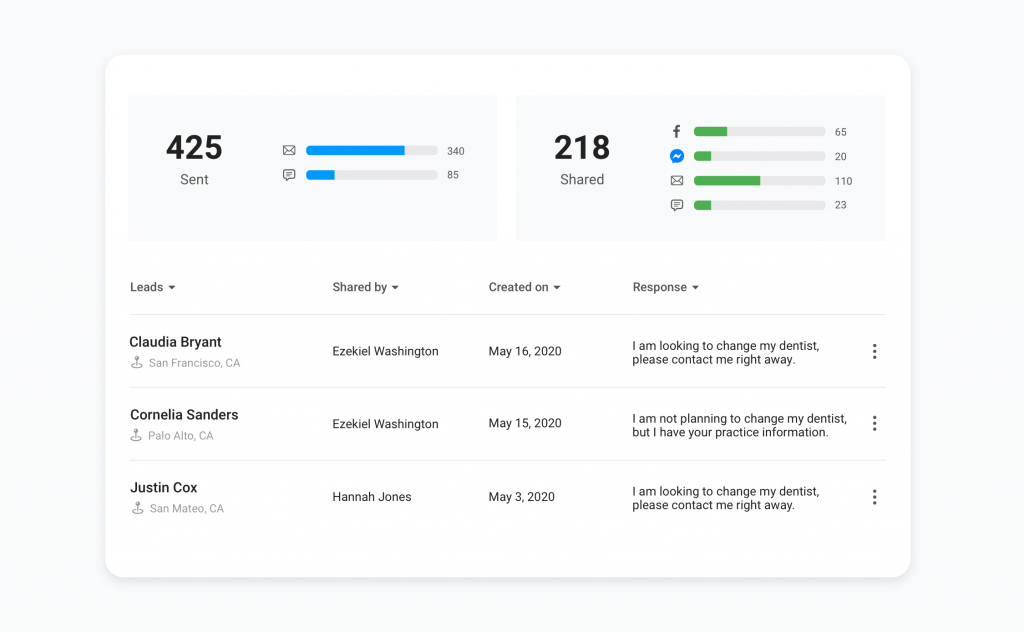
While you’re here, you can also check out this article on how to start a referral rewards program that actually works.
Referral marketing for B2B vs. B2C
Referral marketing is a great tool for B2B (business to business) and B2C (business to consumer) businesses alike, however, there are some key differences between them. Learn how referral marketing strategies differ between the two so you can create the right strategy for your business.
B2B vs. B2C Marketing
If you are embarking on a referral marketing program, keep in mind the key differentiators between B2Bs and B2Cs.
- B2Bs have longer decision-making processes.
There are multiple people to consult and multiple systems to work through before a B2B makes a purchase. It is not enough to convince one person they need your product. Stakeholders, members of the executive team, and other players will need to sign off on a purchase before it can move forward.
- B2Bs want bigger, long-term deals.
Though B2Bs take longer to reach their decision, they are searching for bigger, longer-term deals. Invest your time in the right B2B leads, and you will score big.
- B2Bs seek personalized experience.
What does your product do for them? How can it be used for their business specifically? Have you served similar businesses? All of this information is necessary for B2B to know before they choose your product.
- B2C purchasing decisions are much faster
Marketing should be more focused on grabbing the customer’s attention, rather than building a relationship before a purchase.
- B2C customers have few barriers to purchase
There are fewer steps in the decision-making process, oftentimes the decision-maker and the buyer are the same.
- B2C relationships tend to be built post-purchase, rather than pre-purchase.
While many B2Bs want to have an established relationship with the company before making purchases, B2C customers build relationships through repeat purchases, the support provided, and continuous brand engagement.
Recommended read: How to boost your business messaging with text abbreviations
How do these differences impact referral marketing strategies?
For B2B referral marketing, your business will want to follow these steps.
Step 1 Identify your current customer satisfaction
To evaluate, ask questions like:
- Are your customers generally happy with your product?
- Do you have great reviews and customer feedback?
If not, find out why. Solve any issues you have with customer experience before jump-starting a referral program.
Step 2: What customers would be great ambassadors?
Take a pulse of your customers and see where they are to see how receptive they would be to a referral program. Ask:
- Do you have businesses that are already referring your business informally?
- Do you have businesses that would be eager to refer you?
Step 3: Create a starter group for your referral program.
After you have identified several interested customers, have them be the first group you reach out to when starting a referral program.
For B2Bs, avoid sending customers referral requests right after they have made a deal with your business. Though it may be tempting, your customers will want to have an established relationship with you before they can refer your business. Wait until your relationship is established and you know that they are happy with your product and service before you request a referral.
For B2C Marketing, consider the tips below for your customer referral program.
- Send referral requests right after purchase. B2C consumers will not need a long time to consider whether they want to refer your business. Request referrals after the consumer has purchased to capture their attention and reach them when they are happiest.
- Make them feel like one of the team. B2C consumers love to feel involved with brands that they are passionate about. Use your referral program to get them engaged. Consider setting up a referral rewards program where customers receive swag after sending a certain amount of successful referrals. This will improve their customer experience and encourage them to participate in the referral program.
- Make your referrals shareable. Customers want to be able to share their referrals through social media, text, or messaging apps. The easier you make this sharing, the more likely you are to see engagement with your consumers.
- Utilize social media. Feature your top ambassadors on your social media channels. Your customers will love this recognition, encouraging them to keep spreading the word.
Referral programs are valuable for both B2Bs and B2Cs, however, the approach you take may need to be monitored slightly to fit your customer’s needs best.
Examples of referral marketing programs
Here are some examples of how different businesses have executed some very successful referral marketing programs:
Airbnb
Airbnb pays customers for referrals in the form of Airbnb credits. In this two-sided reward, both the referrer and the person who has been referred win, and there is no limit to how many people a customer can refer.
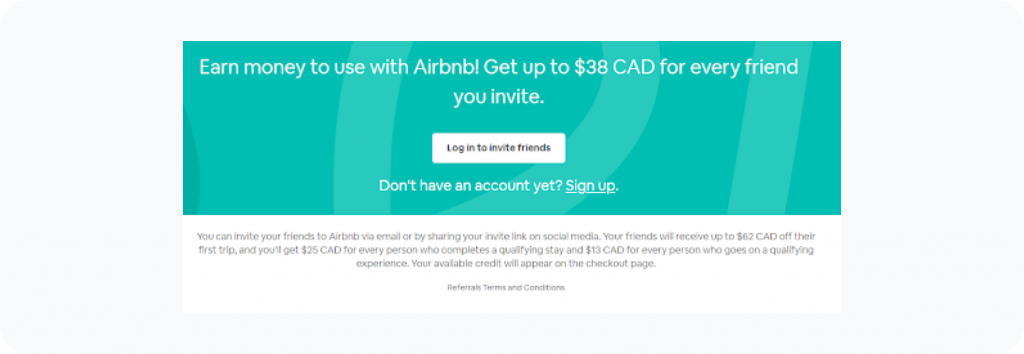
Dropbox
Dropbox is a referral marketing success story. They experienced 3900% growth by offering a two-sided reward program, where both the referrer and the newly-referred customer were rewarded with 16GB of free space. By offering a compelling incentive and making the referral process a breeze, Dropbox was able to grow its customer base at an astonishing rate.
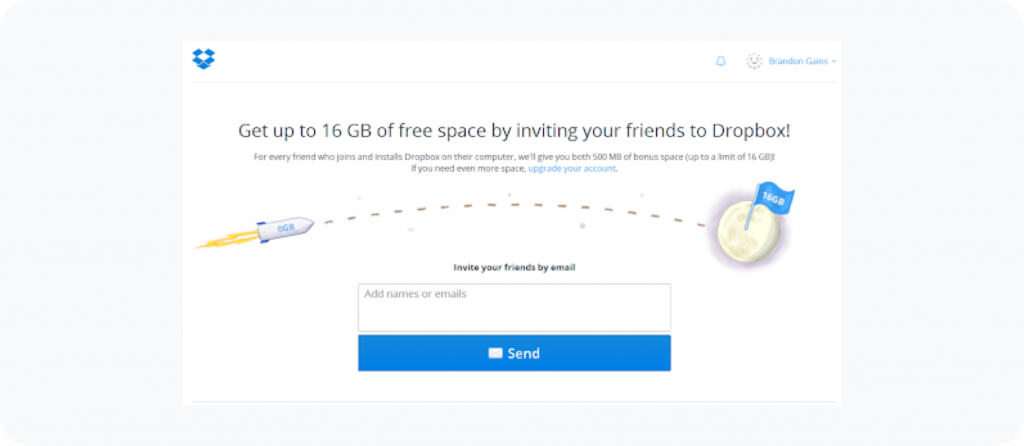
HelloFresh
HelloFresh is getting referrals from customers through its “Refer a Friend” program. Each user gets a unique referral code from HelloFresh, and when their friend redeems that code, both parties receive a discount. Even better? HelloFresh clearly states that there is no limit to how many referrals their customers can make.
HelloFresh also offers a tangible reward program where customers can send friends a free week of meals.
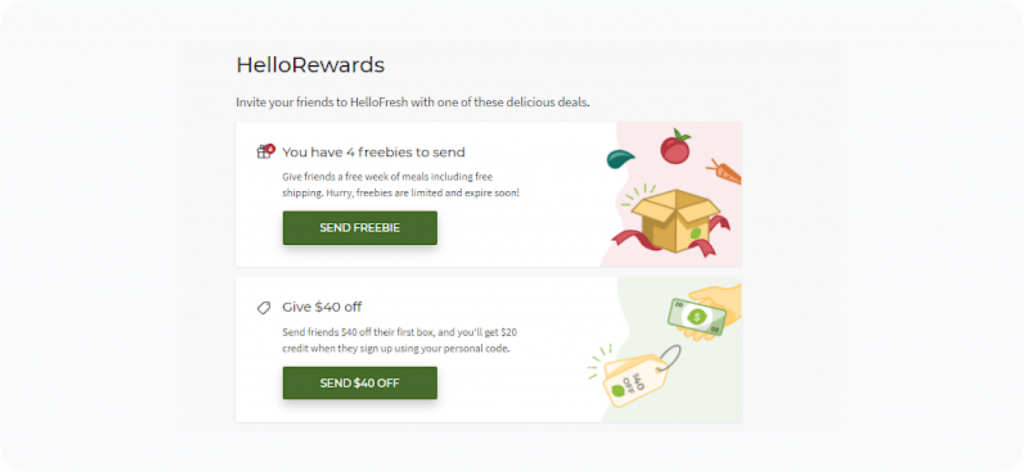
Quip
The toothbrush company Quip has customer referral program benefits where both parties receive $5 off of their order for participating in the referral program.
These companies demonstrate a range of benefits. It’s important to note that some of them are as small as $5. This just goes to show, if you are engaging with your happy customers, they will be eager to spread the word about your brand, regardless of the size of their reward.
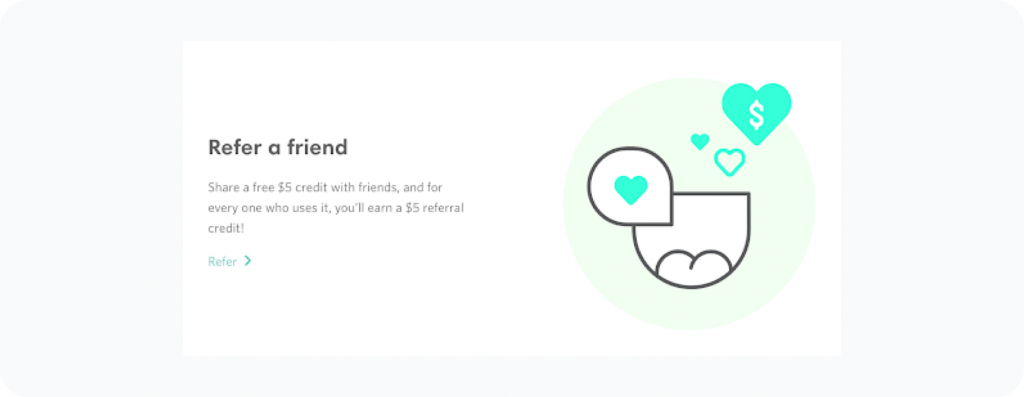
Birdeye Referral – Your ultimate referral marketing solution
Referral marketing is intuitive and can be quite rewarding if done the right way. While it might be tempting to do everything manually, remember, referral marketing involves many steps – send referral requests, track who referred your business, which new customer came from which referral request, send a thank you note or a promised gift card, etc.
Efficient deployment, tracking, and monitoring progress are key to the success of any referral program. Good referral marketing software, like Birdeye Referral, can help you successfully implement and monitor your referral marketing plan.
Here’s how Birdeye Referrals get more leads with automated referral campaigns:
- Automation
Create rules to automatically trigger referral requests after payments or positive online reviews, deploy custom campaigns, or send 1:1 referral requests through inbox.
- Integration
Birdeye Referrals allows you to pair with over 3,000 CRMs and PMSs like Salesforce, Hubspot, QuickBooks, Dentrix, and more to nurture leads and track conversions and revenue.
- Customizable templates
Easily customize your referral templates, from messaging and design, to forms and rewards.
This helps in delivering an omnichannel customer experience.
- Real-time notifications
The Referral platform sends you live notifications so that you can connect with new leads quickly convert them into customers.
- Reporting
Easily track the number of referral requests sent, shared, and new leads received across email, text, and social from a single dashboard.
- Referral rewards
Birdeye Referrals helps you boost response rates by employing reward strategies like cash discounts, gifts, and coupons to maximize referral conversion.
Birdeye started as a solution for online reputation management. Here’s this solution that works. Here’s an integration that works with the CMS that everyone’s using. AI is changing the game, and it’s doing it quickly. So it’s not like Birdeye waited until everybody else is using AI, you know, they’re on the forefront of it. I’ve rolled it out to my customers. It’s making their lives easier, and I’m just really pumped about where Birdeye is taking it and not increasing the cost. – Nicole Wood, Owner, Orange Fish
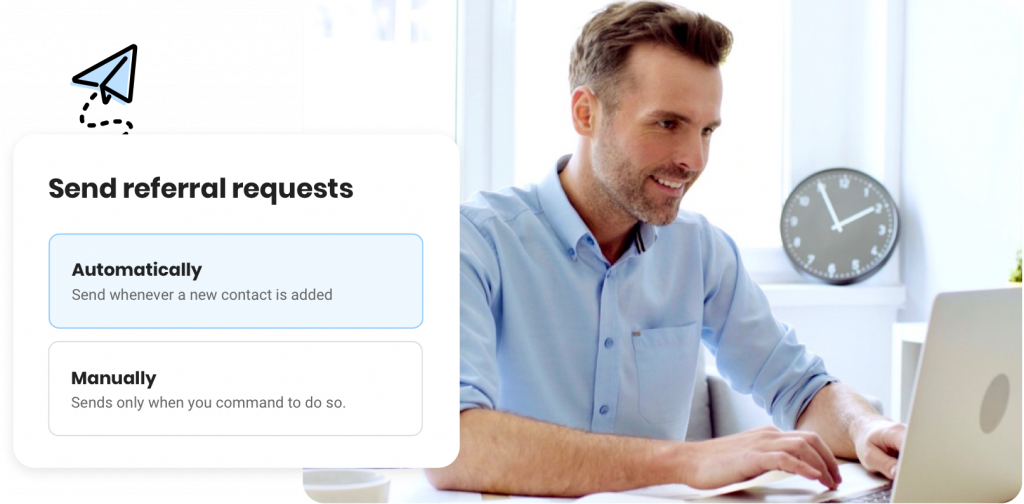
Best practices for your referral program
As you go forward with designing your business’s own referral program, here are some helpful tips and best practices for referral marketing to remember.
- Know your customers
Your referral program cannot be a success if you do not understand who your customers are or what they want. Ask yourself, what do your customers value? What brings them to your business? What keeps them coming back? Once you’ve answered these questions, you can start thinking about what incentives would pique your customer’s interest.
- Visualize success
The more specific you can be with your goals, the better you will be able to identify the effectiveness of your referral program. It’s important that your business is seeing a return on the time, effort, and money you are investing into your referral program. So, ask yourself:
- What does a successful referral program look like to you?
- What are you hoping to achieve from this program?
- Are you trying to growd your customer base?
- Increase your revenue?
Setting the right benchmarks goes hand in hand with visualizing your success. To accomplish this, design your own referral marketing funnel and monitor its progress.
- Be patient
You may not see the benefits from your referral marketing strategy right away. This does not mean that it is not effective. Referral marketing has been proven to have high return on investment, but it does take time. Be patient. Some of your best leads may have received a referral and are simply waiting for the right time to redeem it.
- Make your program your own
Though referral marketing works for many different industries, do not get caught up in comparing your referral program to another business’s. This can distract you from your objective and you could be chasing the wrong goals. Make your referral program your own. Identify what success looks like for your business, and what you can do to get there.
- Always thank your customer
Remember, even if there is an incentive in place, customers are still doing you a favor when they send referrals. Because of this, it’s important to show your appreciation.
Send every customer who refers your business a heartfelt “Thank you” email.
Make sure this email has no other advertisements. If you include mentions of your new products or offers, it may seem like you are trying to get them to spend more money right away.
In this scenario, you will seem opportunistic, not grateful. Sending a “Thank You” email will help your customers feel appreciated and improve their overall customer experience.
How to encourage customers to make referrals?
To encourage customers to make referrals, consider these strategies:
- Offer attractive rewards for successful referrals, like discounts or cash rewards.
- Simplify the referral process to make it easy and user-friendly.
- Regularly inform customers about the referral program using emails and social media.
- Use social proof by sharing success stories from customers who have made referrals.
- Personalize the referral experience to match your customers’ interests.
- Ensure high-quality products and services to make your business worth recommending.
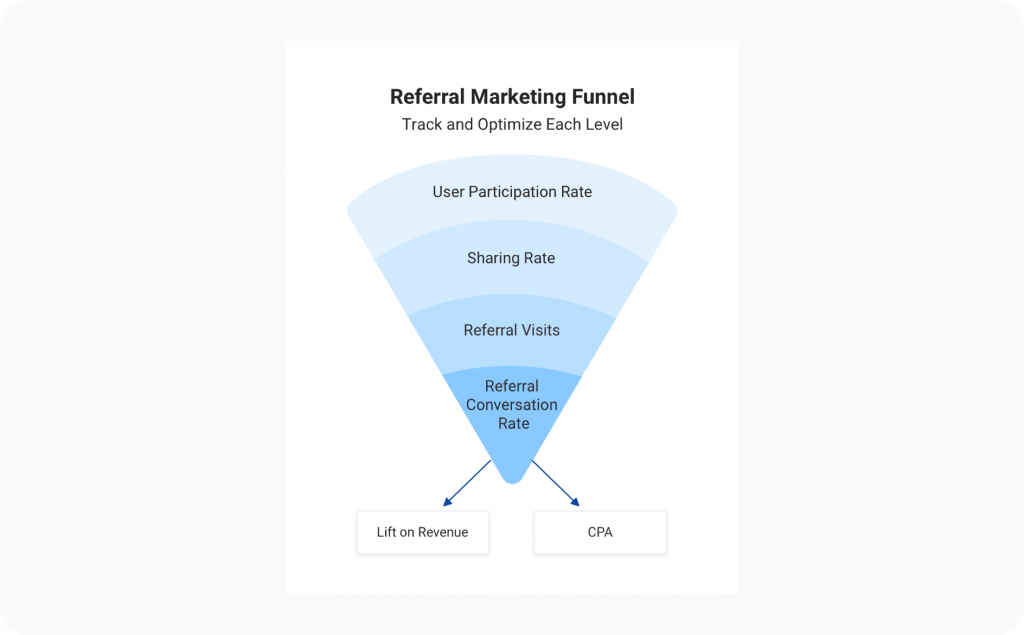
Frequently asked questions about referral marketing
Referral marketing (sometimes called word-of-mouth marketing) is when businesses use the concept of word-of-mouth to get new customers. Happy customers spread the word about the business to their friends and family to help the business grow. Referral marketing programs can take many forms, but all of them use their customers to spread positive word of mouth.
An ambassador program is simply another way to describe a customer referral program. Both terms refer to the same concept: using customer referrals to spread positive word of mouth about a business to help the business attract more customers.
Referral marketing is effective because it leverages the trust and credibility inherent in personal recommendations. People are more likely to try a product or service that friends or family endorse, leading to higher conversion rates and customer loyalty.
To integrate a referral program with your existing marketing strategy, align it with your marketing goals and customer touchpoints. Promote it via email campaigns, social media, and website banners. Also, ensure it complements other promotions and loyalty programs to create a cohesive customer experience.
Common mistakes to avoid in referral marketing include:
Setting unclear program goals.
Overcomplicating the referral process.
Offering unattractive or irrelevant rewards.
Failing to effectively communicate the program details.
Not tracking or analyzing program performance.
Ignoring customer feedback on the program.
Build a strong referral marketing program with Birdeye
When we conducted a survey in 2021, we found that 58% of multi-location marketers initially found their new customers through SEO, online reputation and referrals.
This proves that referral marketing is an investment of your time, as a referred customer is 18% more loyal than a customer acquired by other means.
Amplify the voices of your happy customers and attract new ones long-term with Birdeye Referrals.

Originally published
